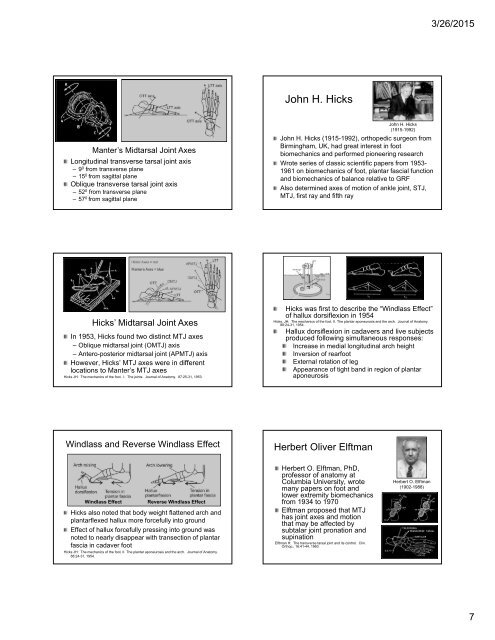History-Evolution-of-Foot-and-Lower-Extremity-Biomechanics-and-Foot-Orthoses_Kevin-Kirby
History-Evolution-of-Foot-and-Lower-Extremity-Biomechanics-and-Foot-Orthoses_Kevin-Kirby
History-Evolution-of-Foot-and-Lower-Extremity-Biomechanics-and-Foot-Orthoses_Kevin-Kirby
Create successful ePaper yourself
Turn your PDF publications into a flip-book with our unique Google optimized e-Paper software.
3/26/2015<br />
Oblique axis<br />
John H. Hicks<br />
Longitudinal<br />
axis<br />
Manter’s Midtarsal Joint Axes<br />
Longitudinal transverse tarsal joint axis<br />
–9 0 from transverse plane<br />
–15 0 from sagittal plane<br />
Oblique transverse tarsal joint axis<br />
–52 0 from transverse plane<br />
–57 0 from sagittal plane<br />
John H. Hicks<br />
(1915-1992)<br />
John H. Hicks (1915-1992), orthopedic surgeon from<br />
Birmingham, UK, had great interest in foot<br />
biomechanics <strong>and</strong> performed pioneering research<br />
Wrote series <strong>of</strong> classic scientific papers from 1953-<br />
1961 on biomechanics <strong>of</strong> foot, plantar fascial function<br />
<strong>and</strong> biomechanics <strong>of</strong> balance relative to GRF<br />
Also determined axes <strong>of</strong> motion <strong>of</strong> ankle joint, STJ,<br />
MTJ, first ray <strong>and</strong> fifth ray<br />
Hicks’ Midtarsal Joint Axes<br />
In 1953, Hicks found two distinct MTJ axes<br />
– Oblique midtarsal joint (OMTJ) axis<br />
– Antero-posterior midtarsal joint (APMTJ) axis<br />
However, Hicks’ MTJ axes were in different<br />
locations to Manter’s MTJ axes<br />
Hicks JH: The mechanics <strong>of</strong> the foot. I. The joints. Journal <strong>of</strong> Anatomy. 87:25-31, 1953.<br />
Hicks was first to describe the “Windlass Effect”<br />
<strong>of</strong> hallux dorsiflexion in 1954<br />
Hicks, JH: The mechanics <strong>of</strong> the foot. II. The plantar aponeurosis <strong>and</strong> the arch. Journal <strong>of</strong> Anatomy.<br />
88:24-31, 1954.<br />
Hallux dorsiflexion in cadavers <strong>and</strong> live subjects<br />
produced following simultaneous responses:<br />
Increase in medial longitudinal arch height<br />
Inversion <strong>of</strong> rearfoot<br />
External rotation <strong>of</strong> leg<br />
Appearance <strong>of</strong> tight b<strong>and</strong> in region <strong>of</strong> plantar<br />
aponeurosis<br />
Windlass <strong>and</strong> Reverse Windlass Effect<br />
Herbert Oliver Elftman<br />
Windlass Effect<br />
Reverse Windlass Effect<br />
Hicks also noted that body weight flattened arch <strong>and</strong><br />
plantarflexed hallux more forcefully into ground<br />
Effect <strong>of</strong> hallux forcefully pressing into ground was<br />
noted to nearly disappear with transection <strong>of</strong> plantar<br />
fascia in cadaver foot<br />
Hicks JH: The mechanics <strong>of</strong> the foot. II. The plantar aponeurosis <strong>and</strong> the arch. Journal <strong>of</strong> Anatomy.<br />
88:24-31, 1954.<br />
Herbert O. Elftman, PhD,<br />
pr<strong>of</strong>essor <strong>of</strong> anatomy at<br />
Columbia University, wrote<br />
many papers on foot <strong>and</strong><br />
lower extremity biomechanics<br />
from 1934 to 1970<br />
Elftman proposed that MTJ<br />
has joint axes <strong>and</strong> motion<br />
that may be affected by<br />
subtalar joint pronation <strong>and</strong><br />
supination<br />
Elftman H: The transverse tarsal joint <strong>and</strong> its control. Clin.<br />
Orthop., 16:41-44, 1960.<br />
Herbert O. Elftman<br />
(1902-1988)<br />
7


